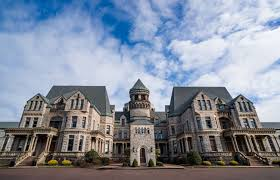The Ohio State Reformatory, commonly known as the Mansfield Reformatory, was originally designed as a progressive institution aimed at reforming young offenders. Construction began in 1886, and the reformatory opened its doors in 1896. Designed by architect Levi T. Scofield, the building is a striking example of Romanesque Revival architecture, characterized by its towering spires, intricate stonework, and grand, imposing fade. The reformatory was intended to be a model facility, with a focus on rehabilitation rather than mere punishment. Its expansive design included a central administration building, a large cell block, and various support structures, all designed to house and reform juvenile offenders. Over the years, the facility grew to accommodate a broader range of prisoners, and its purpose evolved to focus more on incarceration than rehabilitation.
The Era of Incarceration
Throughout the 20th century, the Ohio State Reformatory became notorious for its harsh conditions and overcrowded facilities. By the mid-1900s, the prison was struggling with significant issues, including inadequate medical care, poor living conditions, and frequent riots. These problems, combined with the facility's outdated infrastructure, contributed to a growing reputation for being a grim and challenging place to serve time.
The reformatory was officially closed in 1990, after decades of serving as a maximum-security prison. Following its closure, the site faced numerous challenges, including vandalism and decay. However, it was later preserved and repurposed as a historical site and tourist attraction, offering visitors a chance to explore its storied past.
Architectural Grandeur
One of the most striking features of the Ohio State Reformatory is its architecture. The building’s Gothic Revival style, complete with towering turrets and elaborate stone carvings, makes it a standout example of late 19th-century institutional design. The central cell block, often referred to as the "Old Building," is particularly impressive, with its massive iron bars and intricate design.
The reformatory’s design was intended to convey a sense of grandeur and authority, and it remains an architectural marvel. The building’s layout, including its expansive cell blocks and imposing administration wing, reflects the era’s approach to penal architecture and its emphasis on both control and reform.
The Haunting Mystique
Beyond its architectural and historical significance, the Ohio State Reformatory is renowned for its reputation as a haunted location. Numerous reports of paranormal activity have been documented over the years, making the site a popular destination for ghost hunters and those interested in the supernatural.
Visitors and staff have reported a wide range of eerie occurrences, including unexplained noises, disembodied voices, and shadowy figures. The reformatory’s dark history, combined with its vast and labyrinthine structure, has contributed to its status as a hotspot for ghostly encounters. The site has been featured on various paranormal investigation shows and continues to attract those seeking a brush with the supernatural.
Visiting the Ohio State Reformatory
Today, the Ohio State Reformatory offers a range of tours and events for visitors. Guided tours provide insights into the facility’s history, architecture, and the stories of those who once lived and worked there. Special tours, including night tours and ghost hunts, offer a chance to explore the reformatory after dark and experience its eerie atmosphere firsthand.
The site also hosts various events throughout the year, including historical reenactments, educational programs, and fundraising activities. These events help preserve the reformatory’s history and provide opportunities for the public to engage with its past.
Final Thoughts
The Ohio State Reformatory in Mansfield is more than just a historic prison; it’s a monument to a bygone era of penal reform, a masterpiece of Gothic architecture, and a beacon for those intrigued by the paranormal. Its storied past and haunting allure make it a compelling destination for anyone interested in exploring the intersections of history, architecture, and the supernatural.


No comments:
Post a Comment